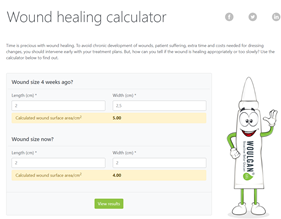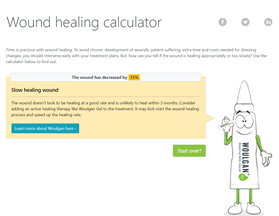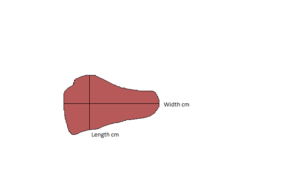Did you know that if a wound hasn’t reduced in size by at least 40% within 4 weeks, its chances of complete healing at 3 months are greatly reduced?1 It’s a simple calculation but, if used well, it can show you which wounds need you to act now to minimise future pain, cost and time.
We all know that slow healing wounds cause patients significant pain and loss of quality of life. They also add cost and time to the work of the nurses caring for them. If we knew a wound was likely to stall, we’d probably all act differently.
In the words of Einstein’s famous quote: “The definition of insanity is doing the same thing over and over and expecting different results”. Apply this to wound healing and it’s clear that using the same treatment plan for months on end with a slow healing wound is an ineffective approach. The difficulty is knowing when to step up the treatment plan. How do you know when you’ve got a wound which is going to need a different intervention to help it heal – and can this be identified and rectified earlier?
There are at least three commonly references points in the timeline of a wound when we can define it as chronic or slow healing:
- Wounds with less than 40% size reduction in 4 weeks [1]
- Wounds of 8 weeks duration [2]
- Wounds of 12 weeks duration [3]
General consensus among wound care experts suggests that early intervention prevents wounds from becoming chronic. Based on this, an indication at 4 weeks gives us a head start in identifying those problem wounds ahead of time, and lets us put in place a timely intervention to make a difference.
Measuring the wound healing progress has never been easier
So now you know when, but what about the how? Short for time or just not a fan of mathematical calculations? Well, the good news is that we’ve got your back! We’ve developed a free online wound calculator that does the maths for you. It is super easy to use – all you need to do is:
- Enter wounds size 4 weeks ago
- Enter current wound size
- Click “View Results”
 |
 |
At the click of a button you can see if your wound has passed the magic 40% reduction or not. If not, you can consider changing your current treatment plans. It’s like a crystal ball for wounds, helping you to predict future problems and act now.
Remember if the dressings you are considering are all defined as standard care, changing just the dressing type is really not a treatment change! If you want to learn more about how to assess wounds and make treatment changes, visit our reACTivate resource centre for more help.
Also, keep in mind that your input data affects your results, so if possible the same individual should carry out the measurements of the wound. However the most important thing is to track the wound progress regularly (at 4 weeks intervals) by measuring the wound size. For considerations of how to best measure the wound size, read on.
How to measure a wound:
There are various tools and software available that can measure the wound size, circumference and create graphs of the wound progression just from a photo. Those fancy tools are neat and can be very helpful, especially if you’re involved in clinical trials or evaluations where the demand for accuracy is high. If you got one you’re all set –if you don’t you can still manage! There are mainly two ways of measuring a wound manually:
- Accurately but somewhat laboriously
- Less accurate, but fast and sufficient
If you want to go with the first option, you can find a nice guide here (NB downloads a word doc-look for it at the bottom left side): https://www.oxfordhealth.nhs.uk/wp-content/uploads/2015/08/Calculating-wound-surface-area-and-size-reduction.docx
If you want to go for the second option you need a ruler to measure the length and the width at the widest parts of the wound (figure below). Make sure to note the measurements and the date in the patient journal and continue measuring at the same locations at regular intervals during the treatment. Keep in mind that different individuals performing the measurements will arrive at slightly different results, however the most important thing is that you measure, document and follow the wound size at regular intervals (minimum 4 weeks) of the treatment. Use our wound calculator to assess your progress and make changes to the treatment if the healing is too slow.

TIP:
If you’re mostly out with patients and not at your desk you can still use the calculator. By creating a shortcut to the wound calculator on your mobile phone or tablet for easy access, you can measure the wound healing progress on the fly. Just go to the calculator page on your device and a popup explaining how to create the shortcut on your home screen will appear. Best of luck healing those wounds!
We all understand the impact of a chronic, slow healing wound. Let’s work together to try to act now and prevent future pain.
References
- Sheehan, P., et al., Percent Change in Wound Area of Diabetic Foot Ulcers over a 4-Week Period Is a Robust Predictor of Complete Healing in a 12-Week Prospective Trial. Plastic and Reconstructive Surgery, 2006. 117(7S): p. 239S-244S.
- Izadi, K. and P. Ganchi, Chronic wounds. Clin Plast Surg, 2005. 32(2): p. 209-22.
- Mustoe, T.A., K. O’Shaughnessy, and O. Kloeters, Chronic Wound Pathogenesis and Current Treatment Strategies: A Unifying Hypothesis. Plastic and Reconstructive Surgery, 2006. 117(7S): p. 35S-41S.